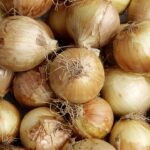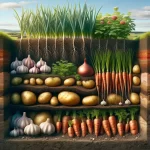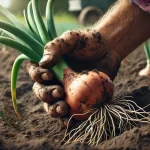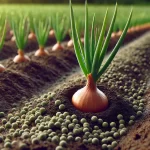Importance of Pest and Disease Control in Onion Cultivation
Onion cultivation is vulnerable to a range of pests and diseases that can severely affect yield and the quality of the final product. Comprehensive and preventive management is essential to minimize losses and ensure the profitability of the crop. This guide details the main pests and diseases that affect onions, as well as recommended control strategies.
Main Pests in Onion Cultivation
Onion Thrips (Thrips tabaci)
Description and Life Cycle
Thrips are small insects, yellow or brown in color, that feed on the sap of leaves, causing silvering, deformities, and weakening of the plants. These insects are especially problematic in warm and dry climates.
- Life Cycle: Thrips reproduce rapidly, completing their life cycle in 2 to 3 weeks under favorable conditions. They can develop multiple generations during the growing season.
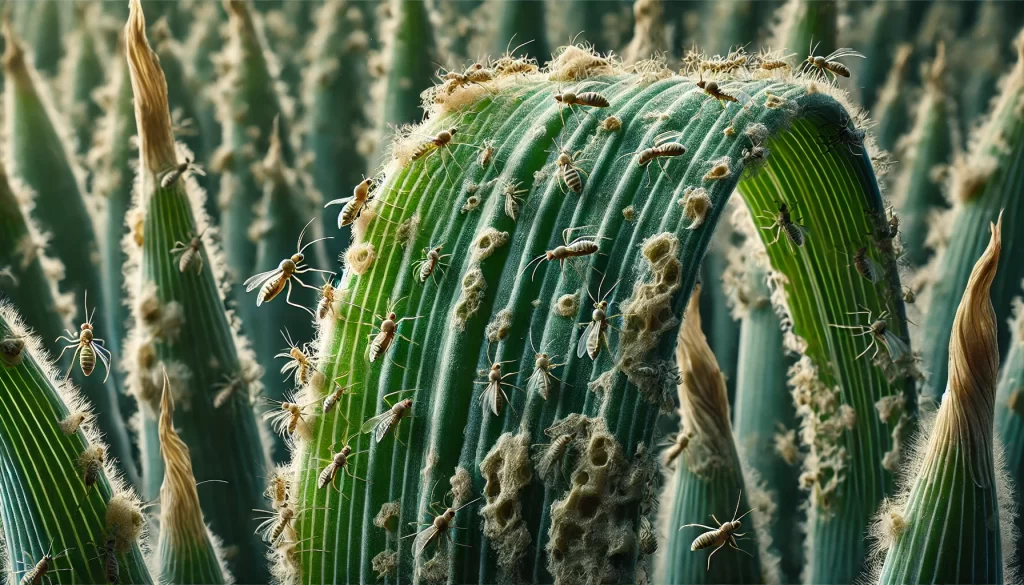
Control Strategies
- Regular Monitoring: Frequently inspect plants, especially during vegetative growth stages.
- Biological Control: Introduction of natural predators such as predatory mites (Amblyseius swirskii) and lacewings.
- Use of Insecticides: Apply specific insecticides during periods of high infestation, prioritizing those with low environmental impact and following technical recommendations to avoid resistance.
Onion Fly (Delia antiqua)
Description and Life Cycle
The onion fly is a pest whose larvae feed on the bulbs, causing rot and weakening the plants. Damage is more severe in the early stages of crop development.
- Life Cycle: The adult fly lays eggs at the base of onion plants, and larvae emerge in a few days, penetrating the bulbs. Several generations can occur per year, depending on weather conditions.
Control Strategies
- Crop Rotation: Avoid planting onions in areas where there was an infestation in the previous season.
- Use of Traps: Place baited traps to reduce the adult population and monitor the presence of the pest.
- Soil Treatment: Apply specific insecticides to the soil before planting or at the beginning of the infestation.
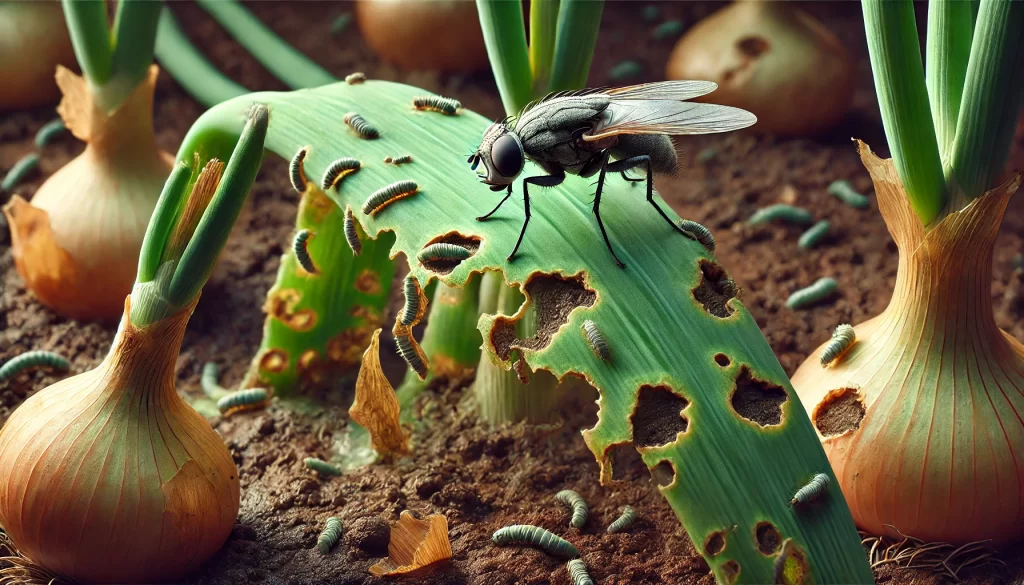
Leaf Miner (Liriomyza spp.)
Description and Life Cycle
The leaf miner is an insect whose larvae burrow tunnels in onion leaves, reducing photosynthetic capacity and weakening the plant.
- Life Cycle: Adult females lay eggs on leaves, and larvae hatch in a few days, beginning to feed immediately. It completes its life cycle in 2 to 3 weeks.
Control Strategies
- Monitoring: Use yellow sticky traps to detect the presence of adults.
- Biological Control: Introduction of parasitoids such as Diglyphus isaea that attack larvae within the leaves.
- Insecticide Application: Use systemic or contact insecticides at the first signs of infestation, following a resistance management program.

Main Diseases in Onion Cultivation
Downy Mildew (Peronospora destructor)
Description and Life Cycle
Downy mildew is a fungal disease that manifests as yellow spots on the leaves, which eventually turn brown and dry, affecting bulb growth and development.
- Life Cycle: The fungus spreads through spores carried by wind and water. High humidity and cool temperatures favor its development.
Control Strategies
- Use of Resistant Varieties: Opt for onion varieties that are less susceptible to downy mildew.
- Water Management: Avoid overhead irrigation that keeps leaves wet for extended periods.
- Fungicide Application: Use preventive and curative fungicides such as mancozeb or fosetyl-aluminum, applied based on weather conditions and disease pressure.

Neck Rot (Botrytis allii)
Description and Life Cycle
Neck rot is a disease caused by the fungus Botrytis allii, which affects the neck area of the bulb, causing it to rot, especially during storage.
- Life Cycle: The fungus develops under conditions of high humidity and moderate temperatures, primarily infecting damaged or decaying tissues.
Control Strategies
- Watering and Harvest Management: Avoid overwatering towards the end of the crop cycle and harvest in dry conditions.
- Proper Curing: Ensure proper curing of bulbs after harvest to reduce susceptibility to infection.
- Fungicide Application: Treat plants with preventive fungicides if conditions are favorable for the disease.

Fusarium Wilt (Fusarium oxysporum)
Description and Life Cycle
Fusarium wilt is a disease caused by the fungus Fusarium oxysporum, which affects the roots and base of the bulb, causing rot and wilting of the plant.
- Life Cycle: The fungus is present in the soil and can survive for long periods. It infects plants through wounds in the roots or by contact with contaminated soil.
Control Strategies
- Crop Rotation: Avoid planting onions in infected fields for several consecutive years.
- Use of Fungicides and Soil Amendments: Apply specific fungicides to the soil before planting and use amendments that improve soil health.
- Control of Growing Conditions: Maintain good soil drainage and avoid waterlogging to reduce the incidence of the disease.

Integrated Pest and Disease Management (IPM) Strategies
Crop Rotation
Crop rotation is one of the most effective strategies to prevent the buildup of pests and diseases in the soil. Alternating onion cultivation with other non-host crops significantly reduces pathogen and pest pressure.
Biological Control
The use of natural enemies, such as predators, parasitoids, and specific pathogens, is an effective tool in pest management. The introduction of beneficial microorganisms into the soil can also help control diseases.
Monitoring and Early Detection
Regular crop monitoring allows for early detection of pests and diseases, facilitating timely intervention and reducing the need for intensive chemical treatments.
Responsible Use of Chemical Products
When the use of insecticides or fungicides is necessary, it is crucial to follow technical recommendations to avoid resistance and minimize environmental impact. This includes rotating products with different modes of action and applying them at the appropriate times.
Cultural Practices and Soil Management
Cultural practices, such as proper soil preparation, the use of organic fertilizers, and irrigation management, contribute to the overall health of the crop and make it more resistant to pests and diseases.
 AgronoBlog – Agriculture Blog
AgronoBlog – Agriculture Blog 